

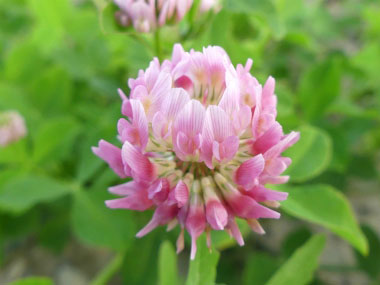
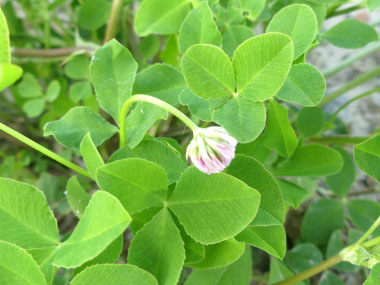
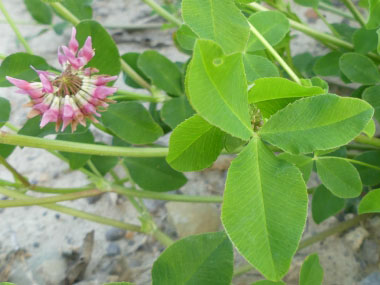
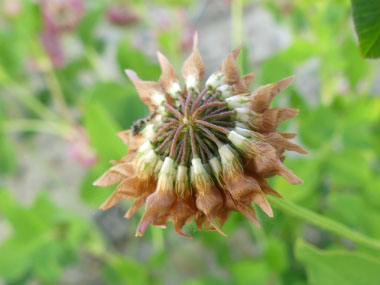
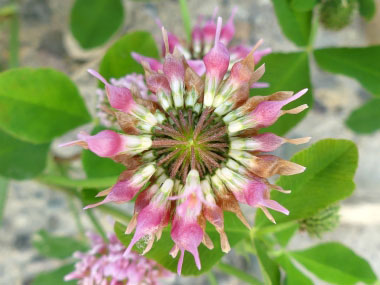
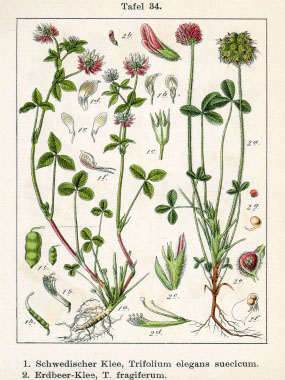
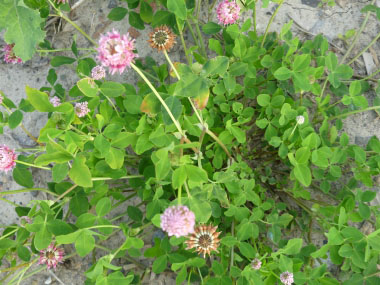
To support our efforts please browse our store (books with health benefits, etc.).
Alsike clover is a perennial native plant of Europe and Asia and it has been widely cultivated at a forage crop around the world. It is in the Fabaceae (pea) family. It readily escapes cultivation as is now widely established along road sides, and waste places throughout almost all the U.S. and Canada. It is similar to the ubiquitous White Clover (Trifolium repens). Also similar is the Red Clover (Trifolium pratense), which has a chevron pattern on the leaflets. Despite its scientific name, alsike clover is not of hybrid origin. The plant gets its common name from the town of Alsike in Sweden from which Linnaeus first described it.
Distinguishing Features
Alsike clover is a plant with a semi-erect, sparsely branched, grooved stem, hairy in its upper regions. The leaves are alternate and stalked with small stipules. The leaves have three blunt-tipped ovate, unspotted leaflets with finely toothed margins. The flowers are quite distinct with a white and pink appearance.
Flowers
A single round flower head on a 2.5 to 7 cm (1 to 3”) stalk arising from a leaf axil. Heads are about 2 cm (¾”) diameter, densely packed with tiny pea-shaped flowers. Flowers have a sharply pointed upward curved petal (standard) with small lateral wings below it and a keel in the throat. Flowers are light pink to white turning darker pink with age, giving the head a distinct two-tone colour pattern as lower blossoms on the globe mature first. The short, hairless calyx tube holding the flower is white with distinctly green teeth. Flowers bloom between June and September.
 Fields
of Nutrition has medicinal benefits and vitamin/mineral content of Alsike Clover.
Fields
of Nutrition has medicinal benefits and vitamin/mineral content of Alsike Clover.
Leaves
Leaves are palmately compound in 3's on a stalk up to 7 cm (3”) long. Leaflets are 1 to 2.5 cm (½ to 1”) long, 6 to 8 mm (¼ to 1/3”) wide, hairless, oval to elliptic, rounded at the tip, tapered at base, and stalkless, with very finely serrated sharp teeth around the edges.
Height
Alsike clovers grow anywhere from 30 to 60 cm (10 to 20”) tall.
Habitat
This short lived perennial favours cool moist conditions. It is found on grasslands and mountainsides throughout the cool temperate regions of the world. Alsike clovers also like fields, roadsides, and waste ground locations.
Edible Parts
Leaves and flower heads can be consumed raw or cooked. A healthy tea is made from the dried flower heads. The dried flower heads and seeds can be ground into a nutritious flour.
Similar Plants
Winter Survival Food Handbook

PDF Plant Magazines
Types of Wild Food
Geographic Zones Seasons
Disclaimer
EdibleWildFood.com is informational in nature. While we strive to be 100% accurate, it is solely up to the reader to ensure proper plant identification. Some wild plants are poisonous or can have serious adverse health effects.
We are not health professionals, medical doctors, nor are we nutritionists. It is up to the reader to verify nutritional information and health benefits with qualified professionals for all edible plants listed in this web site. Please click here for more information.
Why Edible Wild Food?
- Food costs are rising
- Free, wild food is readily abundant
- Wild food adds nutrition to your diet
- Wild food can help treat various medical conditions





